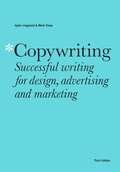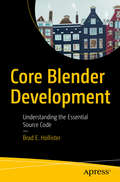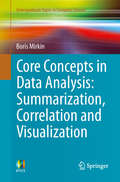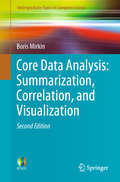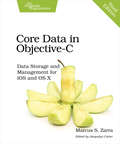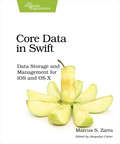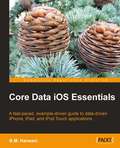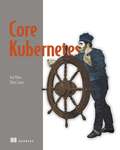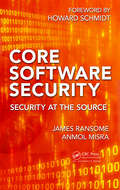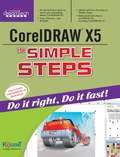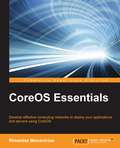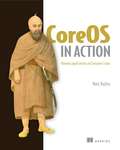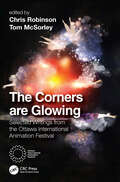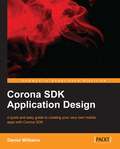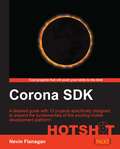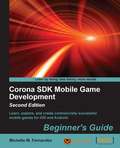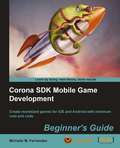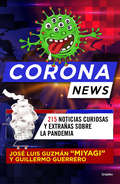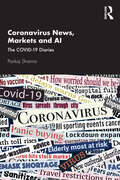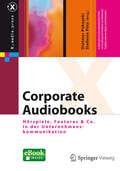- Table View
- List View
Copywriting Third Edition: Successful writing for design, advertising and marketing
by Gyles Lingwood Mark ShawWriting copy is often assumed to be a natural talent. However, there are simple techniques you can employ to craft strong written content with ease. This revised edition teaches the art of writing great copy for digital media, branding, advertising, direct marketing, retailing, catalogues, company magazines and internal communications, and aspects of writing for social media are integrated throughout. There are also new interviews and case studies. Using a series of exercises and up-to-date illustrated examples of award-winning campaigns and communication, *Copywriting, Third Edition takes you through step-by-step processes that can help you to write content quickly and effectively.
Copywriting Third Edition: Successful writing for design, advertising and marketing
by Gyles Lingwood Mark ShawWriting copy is often assumed to be a natural talent. However, there are simple techniques you can employ to craft strong written content with ease. This revised edition teaches the art of writing great copy for digital media, branding, advertising, direct marketing, retailing, catalogues, company magazines and internal communications, and aspects of writing for social media are integrated throughout. There are also new interviews and case studies. Using a series of exercises and up-to-date illustrated examples of award-winning campaigns and communication, *Copywriting, Third Edition takes you through step-by-step processes that can help you to write content quickly and effectively.
Core Blender Development: Understanding the Essential Source Code
by Brad E. HollisterLearn the essential source code of Blender and its unique build system. This book provides the inner workings of the Blender C-based source code, and will be indispensable for those wanting to contribute to this important open-source project.Blender is an open-source 3D modeling and rendering software package used in the production of assets for animated projects, 3D printing, games, and even scientific visualization. This book goes in depth and discusses the primary modules related to the GUI and the geometric modeling work. You'll start by learning how to reverse engineer geometric operators, and from there move on to the main features of the source code and how to apply them. When done, you'll have the necessary foundation for exploration in other modules of the Blender source code. Lack of software engineering knowledge, such as experience with large cross-platform code base, remains insurmountable for many new developers. While the Blender site includes much useful information, it is not detailed enough. Core Blender Development breaks down the barriers to entry for open-source development in 3-D modeling. What You’ll LearnFind the code for various functions and editors in BlenderTrack down bugs, and contribute new functionality to the Blender code baseExamine the .blend file and how it stores Blender stateUnderstand the Blender core code base beyond the community website documentationReview the explicit code traces and source files of descriptions of the code baseWho This Book Is ForPrimarily for novice to intermediate level developers and programmers with an interest in Blender, graphics, and visualization, who likely don’t have experience of reverse engineering a large code base.
Core Concepts in Data Analysis: Summarization, Correlation And Visualization (Undergraduate Topics in Computer Science)
by Boris MirkinCore Concepts in Data Analysis: Summarization, Correlation and Visualization provides in-depth descriptions of those data analysis approaches that either summarize data (principal component analysis and clustering, including hierarchical and network clustering) or correlate different aspects of data (decision trees, linear rules, neuron networks, and Bayes rule). Boris Mirkin takes an unconventional approach and introduces the concept of multivariate data summarization as a counterpart to conventional machine learning prediction schemes, utilizing techniques from statistics, data analysis, data mining, machine learning, computational intelligence, and information retrieval. Innovations following from his in-depth analysis of the models underlying summarization techniques are introduced, and applied to challenging issues such as the number of clusters, mixed scale data standardization, interpretation of the solutions, as well as relations between seemingly unrelated concepts: goodness-of-fit functions for classification trees and data standardization, spectral clustering and additive clustering, correlation and visualization of contingency data. The mathematical detail is encapsulated in the so-called "formulation" parts, whereas most material is delivered through "presentation" parts that explain the methods by applying them to small real-world data sets; concise "computation" parts inform of the algorithmic and coding issues. Four layers of active learning and self-study exercises are provided: worked examples, case studies, projects and questions.
Core Data Analysis: Summarization, Correlation And Visualization (Undergraduate Topics in Computer Science)
by Boris MirkinThis text examines the goals of data analysis with respect to enhancing knowledge, and identifies data summarization and correlation analysis as the core issues. Data summarization, both quantitative and categorical, is treated within the encoder-decoder paradigm bringing forward a number of mathematically supported insights into the methods and relations between them. Two Chapters describe methods for categorical summarization: partitioning, divisive clustering and separate cluster finding and another explain the methods for quantitative summarization, Principal Component Analysis and PageRank.
Core Data in Objective-C: Data Storage and Management for iOS and OS X
by Marcus S. ZarraCore Data is Apple's data storage framework: it's powerful, built-in, and can integrate with iCloud. Discover all of Core Data's powerful capabilities, learn fundamental principles including thread and memory management, and add Core Data to both your iOS and OS X projects. All examples in this edition are based on Objective-C and are up-to-date for the latest versions of OS X El Capitan and iOS 9.Core Data expert Marcus Zarra walks you through a fully developed application based around the Core Data APIs. You'll build on this application throughout the book, learning key Core Data principles such as NSPredicate, NSFetchRequest, thread management, and memory management.Start with the basics of Core Data and learn how to use it to develop your application. Then delve deep into the API details. Explore how to get Core Data integrated into your application properly, and work with this flexible API to create convenience methods to improve your application's maintainability. Reduce your migration difficulties, integrate your Core Data app with iCloud and Watch Kit, and use Core Data in a queue-based environment. By the end of the book, you'll have built a full-featured application, gained a complete understanding of Core Data, and learned how to integrate your application into the iPhone/iPad platform.This third edition updates all examples for OS X El Capitan and iOS 9, and gets you up to speed on changes in multithreading and batch processing. There's a new chapter on efficiently importing data from a network location, and a new discussion of how best to pre-load data into your application.What You Need:Mac OS X El Capitan and iOS 9 and a basic working knowledge of Objective-C
Core Data in Swift: Data Storage and Management for iOS and OS X
by Marcus S. ZarraCore Data is intricate, powerful, and necessary. Discover the powerful capabilities integrated into Core Data, and how to use Core Data in your iOS and OS X projects. All examples are current for OS X El Capitan, iOS 9, and the latest release of Core Data. All the code is written in Swift, including numerous examples of how best to integrate Core Data with Apple's newest programming language.Core Data expert Marcus Zarra walks you through a fully developed application based around the Core Data APIs. You'll build on this application throughout the book, learning key Core Data elements such as NSPredicate, NSFetchRequest, thread management, and memory management.Start with the basics of Core Data and learn how to use it to develop your application. Then delve deep into the API details. Explore how to get Core Data integrated into your application properly, and work with this flexible API to create convenience methods to improve your application's maintainability. Reduce your migration difficulties, integrate your Core Data app with iCloud and Watch Kit, and use Core Data in a queue-based environment. By the end of the book, you'll have built a full-featured application, gained a complete understanding of Core Data, and learned how to integrate your application into the iPhone/iPad platform.This book is based on Core Data in Objective-C, Third Edition. It focuses on Swift and adds an additional chapter on how to integrate Core Data with an efficient network implementation, with best practices on how to load and pre-load data into your Swift application.What You Need:Mac OS X El Capitan and iOS 9 and a basic working knowledge of Swift
Core Data iOS Essentials
by B. M. HarwaniThe book follows an unfolding example app, exploring the features and principles of Core Data as they are added to the app. The book is full of step-by-step instructions, clear explanations, and useful quick reference material.If you've already explored iOS development and maybe even dabbled with Core Data, this book will set your data-driven application development on a firm footing.
Core Kubernetes
by Jay Vyas Chris LoveTake a deep dive into Kubernetes inner components and discover what really powers a Kubernetes cluster. This in-depth guide shines a light on Kubernetes' murky internals, to help you better plan cloud native architectures and ensure the reliability of your systems.In Core Kubernetes you will learn about: Kubernetes base components Kubernetes networking Storage and the Container Storage Interface External load balancing and ingress Kubernetes security Different ways of creating a Kubernetes cluster Configuring Kubernetes to use a GPU To build and operate reliable Kubernetes-based systems, you need to understand what&’s going on below the surface. Core Kubernetes is an in-depth guide to Kubernetes&’ internal workings written by Kubernetes contributors Chris Love and Jay Vyas. It&’s packed with experience-driven insights and advanced techniques you won&’t find anywhere else. You&’ll understand the unique security concerns of container-based applications, minimize costly unused capacity, and get pro tips for maximizing performance. Diagrams, labs, and hands-on examples ensure that the complex ideas are easy to understand and practical to apply. About the technology Real-world Kubernetes deployments are messy. Even small configuration errors or design problems can bring your system to its knees. In the real world, it pays to know how each component works so you can quickly troubleshoot, reset, and get on to the next challenge. This one-of-a-kind book includes the details, hard-won advice, and pro tips to keep your Kubernetes apps up and running. About the book This book is a tour of Kubernetes under the hood, from managing iptables to setting up dynamically scaled clusters that respond to changes in load. Every page will give you new insights on setting up and managing Kubernetes and dealing with inevitable curveballs. Core Kubernetes is a comprehensive reference guide to maintaining Kubernetes deployments in production. What's inside Kubernetes base components Storage and the Container Storage Interface Kubernetes security Different ways of creating a Kubernetes cluster Details about the control plane, networking, and other core components About the reader For intermediate Kubernetes developers and administrators. About the author Jay Vyas and Chris Love are seasoned Kubernetes developers. Table of Contents 1 Why Kubernetes exists 2 Why the Pod? 3 Let&’s build a Pod 4 Using cgroups for processes in our Pods 5 CNIS and providing the Pod with a network 6 Troubleshooting large-scale network errors 7 Pod storage and the CSI 8 Storage implementation and modeling 9 Running Pods: How the kubelet works 10 DNS in Kubernetes 11 The core of the control plane 12 etcd and the control plane 13 Container and Pod security 14 Nodes and Kubernetes security 15 Installing applications
Core Memory
by John Alderman Mark Richards Dag SpicerAn unprecedented combination of computer history and striking images, Core Memory reveals modern technology's evolution through the world's most renowned computer collection, the Computer History Museum in the Silicon Valley. Vivid photos capture these historically important machinesincluding the Eniac, Crays 13, Apple I and IIwhile authoritative text profiles each, telling the stories of their innovations and peculiarities. Thirty-five machines are profiled in over 100 extraordinary color photographs, making Core Memory a surprising addition to the library of photography collectors and the ultimate geek-chic gift.
Core Software Security: Security at the Source
by James Ransome Anmol Misra"... an engaging book that will empower readers in both large and small software development and engineering organizations to build security into their products. ... Readers are armed with firm solutions for the fight against cyber threats."—Dr. Dena Haritos Tsamitis. Carnegie Mellon University"... a must read for security specialists, software developers and software engineers. ... should be part of every security professional’s library." —Dr. Larry Ponemon, Ponemon Institute"... the definitive how-to guide for software security professionals. Dr. Ransome, Anmol Misra, and Brook Schoenfield deftly outline the procedures and policies needed to integrate real security into the software development process. ...A must-have for anyone on the front lines of the Cyber War ..." —Cedric Leighton, Colonel, USAF (Ret.), Cedric Leighton Associates"Dr. Ransome, Anmol Misra, and Brook Schoenfield give you a magic formula in this book - the methodology and process to build security into the entire software development life cycle so that the software is secured at the source! "—Eric S. Yuan, Zoom Video CommunicationsThere is much publicity regarding network security, but the real cyber Achilles’ heel is insecure software. Millions of software vulnerabilities create a cyber house of cards, in which we conduct our digital lives. In response, security people build ever more elaborate cyber fortresses to protect this vulnerable software. Despite their efforts, cyber fortifications consistently fail to protect our digital treasures. Why? The security industry has failed to engage fully with the creative, innovative people who write software.Core Software Security expounds developer-centric software security, a holistic process to engage creativity for security. As long as software is developed by humans, it requires the human element to fix it. Developer-centric security is not only feasible but also cost effective and operationally relevant. The methodology builds security into software development, which lies at the heart of our cyber infrastructure. Whatever development method is employed, software must be secured at the source. Book Highlights: Supplies a practitioner's view of the SDL Considers Agile as a security enabler Covers the privacy elements in an SDL Outlines a holistic business-savvy SDL framework that includes people, process, and technology Highlights the key success factors, deliverables, and metrics for each phase of the SDL Examines cost efficiencies, optimized performance, and organizational structure of a developer-centric software security program and PSIRT Includes a chapter by noted security architect Brook Schoenfield who shares his insights and experiences in applying the book’s SDL framework View the authors' website at http://www.androidinsecurity.com/
CorelDRAW X5 In Simple Steps
by Kogent Learning Solutions IncCoreldraw X5 In Simple Steps (Hindi) Author: Kogent Learning Solutions Inc.
CoreOS Essentials
by Rimantas MoceviciusIf you are a system administrator with experience in network virtualization and want to develop computing networks for deploying applications and servers, then this is the book for you. Knowledge of Linux operating systems and Docker is expected.
CoreOS in Action: Running Applications on Container Linux
by Matt BaileySummaryCoreOS in Action is a clear tutorial for deploying container-based systems on CoreOS Container Linux.Purchase of the print book includes a free eBook in PDF, Kindle, and ePub formats from Manning Publications.About the TechnologyTraditional Linux server distributions include every component required for anything you might be hosting, most of which you don't need if you've containerized your apps and services. CoreOS Container Linux is a bare-bones distro with only the essential bits needed to run containers like Docker. Container Linux is a fast, secure base layer for any container-centric distributed application, including microservices. And say goodbye to patch scheduling; when Container Linux needs an update, you just hot-swap the whole OS.About the BookCoreOS in Action is a clear tutorial for deploying container-based systems on CoreOS Container Linux. Inside, you'll follow along with examples that teach you to set up CoreOS on both private and cloud systems, and to practice common sense monitoring and upgrade techniques with real code. You'll also explore important container-aware application designs, including microservices, web, and Big Data examples with real-world use cases to put your learning into perspective.SummaryHandling scaling and failures gracefullyContainer-driven application designsCloud, on-premises, and hybrid deploymentSmart logging and backup practicesAbout the ReaderWritten for readers familiar with Linux and the basics of Docker.About the AuthorMatt Bailey is currently a technical lead at ZeniMax. He has worked in higher education and with scientific computing, medical, and networking technology companies, as well as a few startups. You can find him online via https://mdb.io.Table of ContentsPART 1 - GETTING TO KNOW COREOSIntroduction to the CoreOS familyGetting started on your workstationExpecting failure: fault tolerance in CoreOSPART 2 - APPLICATION ARCHITECTURECoreOS in productionApplication architecture and workflowWeb stack application exampleBig Data stackPART 3 - COREOS IN PRODUCTIONCoreOS on AWSBringing it together: deploymentSystem administration
The Corners are Glowing: Selected Writings from the Ottawa International Animation Festival
by Chris Robinson & Tom McSorleyThe Ottawa International Animation Festival (OIAF) began in 1976 and stands today as one of the oldest and largest animation events in the world. One of the unique features of the OIAF is the inclusion of commissioned writings that provide attendees with a more in-depth background into the festival’s special screenings. These writings have not only contextualized the festival presentations but have also contributed significantly to animation education and scholarship. The Corners are Glowing is a selection of the best writings (many unseen for decades) culled from past OIAF catalogues. These wide-ranging texts cover the spectrum of animation from the familiar (Daffy Duck, Pee Wee Herman, Bob Clampett, Joanna Quinn, Hiyao Miyazaki, Frank Tashlin) to the more esoteric (Robert Breer, Emily Pelstring, Taku Furukawa, Michael Sporn, and even the use of furniture in animation!). The Corners are Glowing is a valuable time capsule that celebrates animation’s past and present, and the styles of writing are as diverse, enlightening, and fun as the animation subjects being written about.
Corona SDK Application Design
by Daniel WilliamsA step by step tutorial that focuses on everything from setup to deployment of basic apps.Have you ever wanted to create your own app? Then this book is for you. You will learn how to create apps using Corona SDK and how to publish your app so others can get a glimpse of your creation. This book is aimed at both Android and iOS app developers. The reader must have basic knowledge of app development.
Corona SDK Hotshot
by Nevin FlanaganUsing a project based approach you will learn the coolest aspects of Corona SDK development. Each project contains step- by-step explanations, diagrams, screenshots, and downloadable materials.This book is for users who already have completed at least one simple app using Corona and are familiar with mobile development using another platform and have done Lua programming in another context. Knowledge of the basic functions of Corona routines, as well as an understanding of the Lua programming language's syntax and common libraries, is assumed throughout.
Corona SDK Mobile Game Development: Beginner's Guide - Second Edition
by Michelle M. FernandezThis book is for anyone who wants to have a go at creating commercially successfully games for Android and iOS. You don't need game development or programming experience.
Corona SDK Mobile Game Development: Beginner's Guide
by Michelle M. FernandezYou will learn by doing. First a brief crash course in Lua and Corona. Once this is done you will be thrown straight into creating fully functional complete games chapter by chapter. Certain chapters are reserved for adding advanced features such as multiple device integration, social networking and monetization. This book is for anyone who wants to have a go at creating commercially successfully games for Android and iOS. You don't need game development or programming experience.
Corona und die anderen Wissenschaften: Interdisziplinäre Lehren aus der Pandemie (ars digitalis)
by Peter Klimczak Denis Newiak Christer PetersenDie Corona-Pandemie hat die gesamte Welt weitestgehend unvorbereitet getroffen, Entscheidungsträger*innen auf allen gesellschaftlichen Ebenen vor enorme Herausforderungen gestellt und ihnen schwerwiegende Entscheidungen unter weitestgehend unbekannten Voraussetzungen abverlangt. Gerade deswegen braucht es ein stärkeres Hinhören, was die anderen Wissenschaften, denen weniger Aufmerksamkeit zukam als etwa der Virologie, Epidemiologie, Pneumologie, zur Bewältigung beizutragen haben: Was können wir aus den vielfältigen Perspektiven der vielen anderen Wissenschaften zur Bewältigung der Corona-Krise und zukünftiger Pandemien lernen? Welche Erkenntnisse der vielen anderen Fächer wurden in den zurückliegenden Jahren und Monaten nicht ausreichend wahrgenommen und beherzigt? Welchen gesamtgesellschaftlichen Beitrag können diese Fächer zur Krisenbewältigung leisten und welche Voraussetzungen müssen dafür erfüllt sein?
Coronanews: 215 noticias curiosas y extrañas sobre la pandemia
by José Luis Guzmán "Miyagi" Guillermo GuerreroCoronanews es un recuento de 215 noticias de todo el mundo acerca del comportamiento más curioso, extraño e involuntariamente humorístico de la pandemia que nos azota# todo verídico. Las consecuencias de la actual crisis de salud por el Coronavirus son varias, diversas y solo el tiempo las pondrá en su justa dimensión. Una de las más cercanas y obvias ocurrirá en enero del 2021, cuando nazcan todos los chamacos que fueron concebidos porque sus papás estaban aburridos durante la cuarentena. Será esa generación, que no sabemos si se llamará cuarentennials o pandemials, la encargada de contar como si fuera una leyenda urbana que un día nos quedamos encerrados, viendo las mismas películas una y otra vez, temerosos de contagiarnos de un virus que llegó de China. Tal vez sea el principio del fin de la llamada "Era de los sabores silvestres" (ye wei en mandarín) en la cocina china que incluye comerse todo lo que camine, vuele o se arrastre. El SARS-Cov-2 parece provenir del murciélago y en el menú de cualquier mercado chino, por ejemplo, el de Chatou en Cantón, usted puede encontrar cigüeñas, gaviotas, garzas, grullas, ciervos, caimanes, cocodrilos, jabalís, civetas, mapaches, ardillas voladoras, varios tipos de serpientes y tortugas, varios tipos de rana, así como perros y gatos domésticos, todos en venta para comer. ¿Cuántas enfermedades potenciales estarán agazapadas esperando dar el salto zoonótico de una especie a otra? O tal vez no tenemos que ser tan apocalípticos e integrados y esto es un susto pasajero y en las bodas se bailarán las cumbias que hicimos durante 2020. En las bibliotecas digitales de 2050 encontrarán este libro y pensarán que las Coronanews fueron un invento del gobierno y no podrán creer que un doctor salía todos los días a las siete de la noche a decirnos que ya merito llegábamos al pico de la pandemia una y otra vez. A esos lectores del futuro les decimos: quédense en casa y no coman animales raros, no saben el desmadre que se armó.
Coronavirus News, Markets and AI: The COVID-19 Diaries
by Pankaj SharmaCoronavirus News, Markets and AI explores the analysis of unstructured data from coronavirus related news and the underlying sentiment during its real-time impact on the world and on global financial markets, in particular. In an age where information, both real and fake, travels in the blink of an eye and significantly alters market sentiment daily, this book is a blow by blow account of economic impact of the COVID-19 pandemic. The volume: Details how AI driven machines capture, analyse and score relevant on-ground news sentiment to analyse the dynamics of market sentiment, how markets react to good or bad news across ‘short term’ and ‘long term’; Investigates what have been the most prevalent news sentiment during the pandemic, and its linkages to crude oil prices, high profile cases, impact of local news, and even the impact of Trump’s policies; Discusses the impact on what people think and discuss, how the COVID-19 crisis differs from the Global Financial Crisis of 2008, the unprecedented disruptions in supply chains and our daily lives; Showcases how easy accessibility to big data methods, cloud computing, and computational methods and the universal applicability of these tool to any topic can help analyse extract the related news sentiment in allied fields. Accessible, nuanced and insightful, this book will be invaluable for business professionals, bankers, media professionals, traders, investors, and investment consultants. It will also be of great interest to scholars and researchers of economics, commerce, science and technology studies, computer science, media and culture studies, public policy and digital humanities.
Corpora and Language Education
by Lynne FlowerdewCorpora and Language Education provides a comprehensive overview of the field and includes a discussion of the historical and conceptual background of corpus linguistics. The five main approaches to corpus linguistics are critically reviewed. Quotations, definitions and key concepts are included in the main text to highlight important issues and competing voices. The author illustrates how corpus linguistics has been applied in various research fields, e. g. business and health care contexts, forensic linguistics, literary stylistics, translation studies, second language acquisition, lexicography and testing. The application of corpus linguistics techniques to pedagogy is also discussed. Ten exemplary case studies illustrating 'best practices' research are outlined and commented on. The volume also provides a comprehensive list of key print and online resources.
Corpora and Translation Education: Advances and Challenges (New Frontiers in Translation Studies)
by Jun Pan Sara LaviosaThis edited book covers a range of topics related to the use of corpora in translation education, including their standing in corpus-based translation studies, their relationship with machine learning and post-editing, recent advances in learner corpora development and the integration of corpora into translation pedagogy.The book draws the reader into the latest debate on the potential benefits and challenges of using corpora in translation education, as well as serving as practical guidance on how to incorporate corpora into their teaching practice.The book is of particular interest to translation educators, researchers, and postgraduate students who are interested in exploring theoretical underpinnings as well as new ways of teaching and learning translation.
Corporate Audiobooks: Hörspiele, Features & Co. in der Unternehmenskommunikation (X.media.press)
by Dietmar Pokoyski Stefanie PützDie Kopfhörer auf den Ohren so vieler Menschen belegen es: Audio-Medien sind aus unserem Alltag nicht mehr wegzudenken. Auch Unternehmen haben längst den Nutzen des Audio-Kanals für ihre Corporate Identity erkannt. Audio-Branding und Podcasts sind unverzichtbare Elemente einer zeitgemäßen Unternehmenskommunikation geworden. Doch eines ist auffällig: Während das Hörbuch im Consumer-Bereich einen regelrechten Boom erlebt, werden narrative und dokumentarische Audio-Formate in Unternehmen nur selten eingesetzt. Dabei bergen Hörspiele und Features ein besonders hohes Potenzial als Instrument der Mitarbeiter- und Kundenbindung. "Corporate Audiobooks" widmet sich ausführlich diesem bislang unterschätzten Medium. Erstmals bietet ein deutschsprachiges Buch einen Überblick über Geschichte, Methoden und Nutzen narrativer und dokumentarischer Audio-Formate im Kontext der internen und externen Unternehmenskommunikation - ob als attraktiv gestaltete CD und/oder als Audio-Clip fürs Inter- und Intranet.
